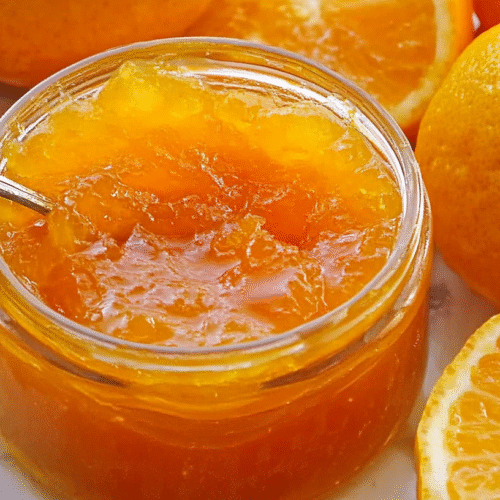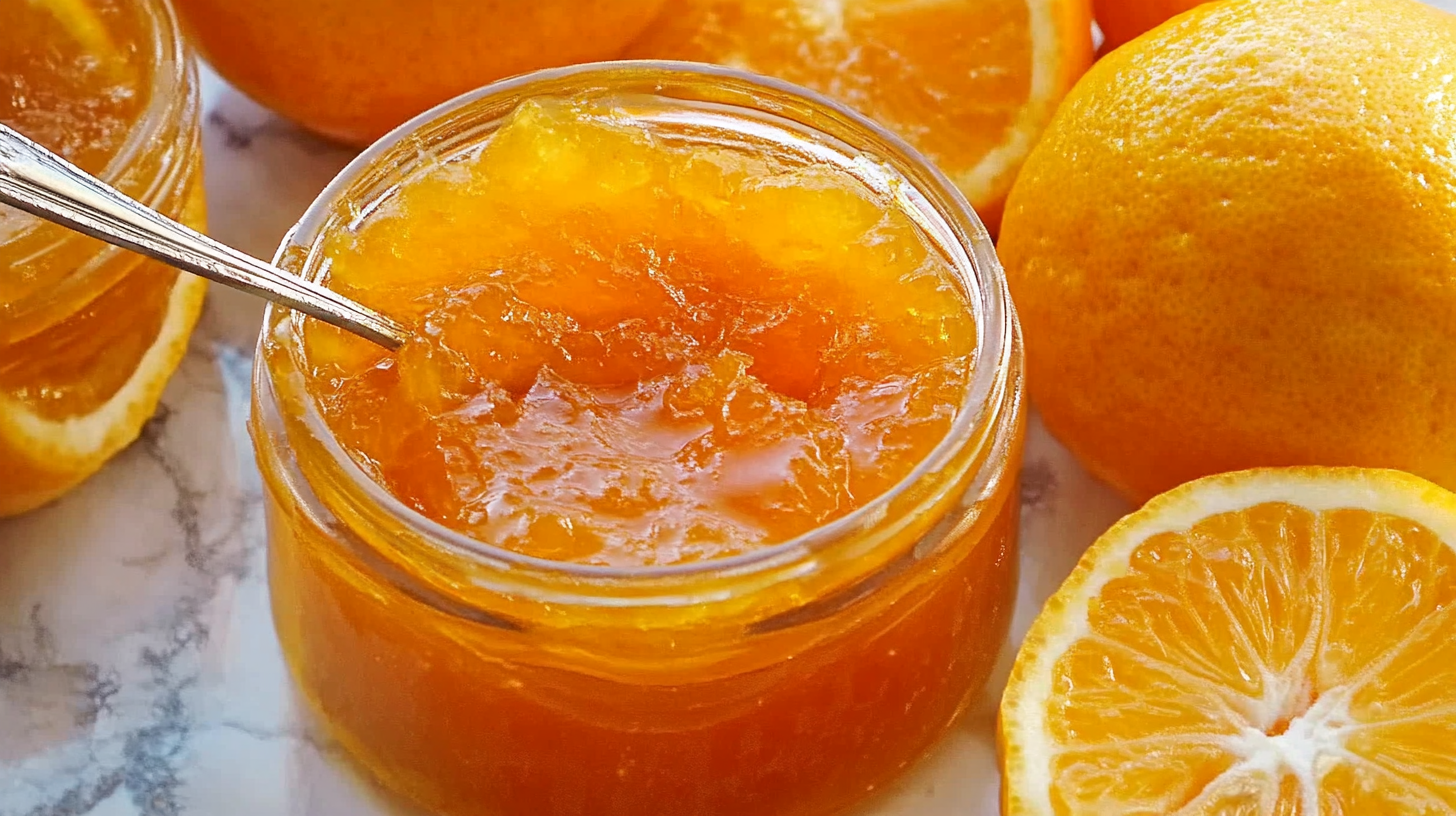A Sunshine-Filled Tradition
There’s something absolutely magical about the way sunlight filters through a jar of homemade citrus marmalade, creating a amber-gold glow that promises brightness with every spoonful. This Orange and Lemon Marmalade recipe is an absolute game changer in my kitchen, bringing the essence of Italian preserving traditions right to your breakfast table. Growing up, my nonna would spend winter afternoons transforming citrus into liquid gold, filling our home with the most intoxicating aromas. The way she carefully sliced each peel into delicate ribbons was nothing short of mesmerizing. This recipe, passed down through generations and perfected in my family’s Tuscan kitchen, elevates the humble citrus preserve to next-level deliciousness. Every jar captures sunshine in a way no store-bought version ever could.
Why You’ll Love This Recipe
You’ll fall head over heels for this marmalade because it strikes that perfect balance between sweet and tart that makes Italian preserves truly special. The combination of oranges and lemons isn’t just delicious—it represents the Mediterranean sunshine that’s central to Italian cuisine. What makes this recipe authentically Italian is the patience it requires; allowing the peels to soak overnight is a traditional technique that extracts maximum flavor while ensuring perfect texture. I’ve simplified my nonna’s method without sacrificing quality, making this accessible even for first-time preserve makers. The slow-cooking approach might seem time-consuming, but it’s mostly hands-off—just the way Italians appreciate good food: unhurried and made with love. Trust me, the bright, complex flavor profile is worth every minute.
Ingredients
For the Marmalade:
- 4 large organic oranges (preferably unwaxed Navel or Valencia)
- 2 organic lemons (preferably Sorrento lemons if available)
- 8 cups filtered water
- 4 cups granulated sugar
- 1 vanilla bean, split lengthwise (optional but recommended)
- 1 small cinnamon stick (approximately 2 inches)
Additional Items for Preserving:
- 6-8 sterilized glass jars with lids (8 oz/240ml each)
- 1 large square of muslin cloth for collecting seeds and pith
Optional Flavor Variations:
- 2 tablespoons grappa or Amaro (for adult version)
- 1 sprig of fresh rosemary
- 1/2 teaspoon red chili flakes for a subtle heat
- Zest of 1 blood orange (added in final cooking stage)
Detailed Instructions
Day One: Preparation
- Prepare your citrus: Wash the oranges and lemons thoroughly under warm water, gently scrubbing the peels to remove any wax coating. Pat completely dry with clean kitchen towels.
- Slice the fruit: Using a sharp knife, cut the oranges and lemons in half crosswise. Squeeze the juice from each half into a large, non-reactive bowl (glass or ceramic works perfectly), being careful to catch any seeds. Place all seeds on your muslin cloth.
- Prepare the peels: Cut each emptied citrus half into quarters. Using a teaspoon, carefully scrape away most of the white pith from inside each peel section, adding this pith to your muslin cloth. This step reduces bitterness—my nonna taught me that leaving some pith creates texture, but too much makes the marmalade unpleasantly bitter.
- Slice the peels: Place each peel section flat on your cutting board and slice into thin ribbons, approximately 1/8-inch thick. For a more rustic texture (the way my family prefers it), you can slice some pieces slightly thicker. Add all sliced peels to the bowl with the juice.
- Create your flavor pouch: Gather the edges of the muslin cloth containing the seeds and pith, tie securely with kitchen string, and add to the bowl. The seeds and pith contain natural pectin that will help your marmalade set beautifully without commercial additives.
- First soak: Add the water to the bowl, cover with a clean tea towel, and let stand at room temperature overnight (or at least 8 hours). This soaking is essential—it allows the peels to soften and begins extracting the natural pectin.
Day Two: Cooking the Marmalade
- Initial cooking: Transfer the entire mixture, including the muslin bag, to a large, heavy-bottomed pot. Add the cinnamon stick and split vanilla bean. Bring to a gentle boil, then reduce heat to maintain a simmer. Cook uncovered for about 1.5-2 hours, or until the peels are completely tender. You’ll know they’re ready when you can easily cut through a piece with the side of a spoon.
- Add the sugar: Remove the pot from heat. Carefully remove the muslin bag and, using two spoons, press it against the side of the pot to extract as much of the pectin-rich liquid as possible before discarding. Remove the cinnamon stick and vanilla bean (scrape the seeds into the mixture). Add the sugar and stir until completely dissolved.
- Final cooking: Return the pot to medium-high heat and bring to a rolling boil. Cook, stirring occasionally (more frequently as it thickens) for approximately 30-45 minutes. Watch carefully during this stage—the mixture can quickly go from perfect to overcooked.
- Test for doneness: To check if your marmalade is ready, place a small plate in the freezer for 5 minutes. Drop a teaspoon of the hot marmalade onto the cold plate, wait 30 seconds, then run your finger through it. If it wrinkles and doesn’t immediately flow back together, it’s ready. If not, continue cooking for another 5 minutes and test again.
- Rest briefly: When the marmalade has reached the setting point, remove from heat and let stand for 10 minutes. This helps the fruit pieces distribute evenly when jarring.
Preserving Your Marmalade
- Prepare your jars: While the marmalade cooks, sterilize your jars and lids by boiling them for 10 minutes, then keeping them warm in the oven at 225°F (110°C).
- Fill the jars: Using a ladle and funnel, carefully fill each jar with hot marmalade, leaving 1/4-inch headspace. Wipe the rims clean with a dampened paper towel, then seal with lids and bands, tightening just until finger-tight.
- Process the jars: For longer storage, process filled jars in a boiling water bath for 10 minutes (adjust for altitude if necessary). My nonna would simply turn the filled jars upside down for 5 minutes, then rightside up to cool—this creates a vacuum seal, though modern food safety recommends the water bath method.
- Cool and store: Allow the jars to cool completely on a towel-lined counter for 24 hours. Check that each lid has sealed properly (the center should not flex when pressed). Store sealed jars in a cool, dark place for up to 12 months. Once opened, refrigerate and use within 3 months.
Serving Suggestions
This marmalade brings Italian sunshine to your table in countless ways:
- Spread on warm, crusty pane toscano (Tuscan bread)
- Served alongside a cheese board featuring pecorino and aged parmigiano
- Spooned over vanilla gelato for a simple but elegant dessert
- Used as a glaze for roasted poultry (dilute with a bit of olive oil)
- Paired with ricotta on crostini for an easy appetizer
Frequently Asked Questions
Can I reduce the sugar?
While you can reduce the sugar by up to 25%, I don’t recommend going lower. The sugar isn’t just for sweetness—it’s crucial for preservation and achieving the right set. If you prefer a less sweet version, increase the lemon ratio slightly.
My marmalade is too runny. What went wrong?
The most common cause is not cooking it long enough or at a high enough temperature to reach the setting point (220°F/104°C). Next time, cook it longer or add 1-2 tablespoons of commercial pectin.
Can I use other citrus fruits?
Absolutely! In Sicily, they make wonderful blood orange versions, while in Amalfi, their famous lemons take center stage. Feel free to experiment with different citrus combinations while keeping the same total fruit weight.
How can I make a clearer marmalade?
For a jewel-like clarity, avoid stirring too much during the final cooking stage and skim off any foam that rises to the surface. My family prefers the more rustic look, which I find has more character!
The peels have risen to the top of my jars. Is this normal?
Yes! This happens when the marmalade cools too quickly. Simply shake the jar gently before opening, or stir before serving.
A Taste of Family Tradition
Every time I open a jar of this marmalade, I’m instantly transported back to my nonna’s kitchen, where love was measured in spoons of homemade preserves and mornings began with the ritual of spreading liquid sunshine on warm bread. This recipe isn’t just about creating something delicious—it’s about preserving a piece of Italian heritage that celebrates taking simple ingredients and transforming them with patience and care.
These jars make the most heartfelt homemade gifts, especially during winter months when we all need a little brightness. The tradition of sharing preserves from your kitchen is deeply rooted in Italian culture, where food has always been the language of love. Whether you’re enjoying this marmalade at your own breakfast table or gifting it to someone special, you’re participating in a tradition that has brought Italian families together for generations.
I’d love to see how your marmalade turns out! Share your creation by tagging # onlyitalianrecipes.com or leave a comment below with your favorite way to enjoy this sunshine-filled preserve. From my family kitchen to yours—buon appetito!

Orange and Lemon Marmalade
Equipment
- Heavy-bottomed pot
- Muslin cloth
- Glass jars with lids
- Canning funnel
Ingredients
Main Ingredients
- 4 large organic oranges preferably unwaxed Navel or Valencia
- 2 organic lemons preferably Sorrento lemons
- 8 cups filtered water
- 4 cups granulated sugar
- 1 vanilla bean split lengthwise (optional)
- 1 small cinnamon stick approximately 2 inches
Optional Flavor Variations
- 2 tbsp grappa or Amaro for adult version
- 1 sprig of fresh rosemary
- 0.5 tsp red chili flakes for subtle heat
- zest of 1 blood orange add in final stage
Instructions
- Wash and dry all citrus fruits thoroughly. Cut in half, juice into a bowl, saving seeds and pith in muslin cloth. Scrape excess pith from peels.
- Slice peels into thin ribbons and place in juice with the muslin bag containing seeds and pith.
- Cover the mixture with water and let soak overnight at room temperature.
- Transfer the mixture to a heavy pot. Add cinnamon stick and vanilla bean. Bring to boil, then simmer for 1.5-2 hours until peels are tender.
- Remove muslin bag and squeeze out pectin liquid. Remove cinnamon and vanilla. Add sugar and stir to dissolve completely.
- Boil mixture until it reaches setting point (220°F/104°C), about 30–45 minutes. Test on a cold plate for doneness.
- Let marmalade rest for 10 minutes, then ladle into sterilized jars, leaving 1/4-inch headspace.
- Seal jars and process in a boiling water bath for 10 minutes. Cool for 24 hours before storing.

